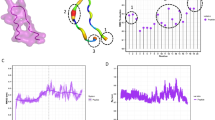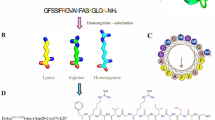Abstract
Antimicrobial peptides (AMPs) are multifunctional compounds that may show antimicrobial and immunomodulatory activities. With the rapid increase in the incidence of multidrug-resistant bacteria, there is an enormous interest in AMPs as templates for the production of new antibiotics. However, there are concerns that the therapeutic administration of AMPs can select resistant strains. In order to distinguish between resistant and non-resistant strains and verify resistance specificity to AMPs, in this study a magainin I-resistant Escherichia coli model was used. First, the identity of all strains was confirmed by matrix-assisted laser desorption ionization-time of flight (MALDI-TOF)-MS, VITEK 2 and MicroScan, and the susceptible and magainin-resistant strains were successfully differentiated by MALDI-TOF-MS analysis. Furthermore, cross-resistances to a broad spectrum of antibiotics were evaluated, showing that all E. coli strains are susceptible to the drugs tested, suggesting that the resistance seems to be specific to AMPs. Finally, the specific resistance to magainin I compared with other AMPs was checked by microdilution. This experiment showed that the magainin MICs were 62 and 104 μM for susceptible and resistant strains, respectively. The other AMPs MICs were 3.4 μM to proline-arginine-rich 39-amino-acid peptide, 43 μM to porcine myeloid antimicrobial 23-amino-acid peptide-23 and 1.2 μM to cecropin P1 for all strains, demonstrating any additional resistance to peptides here evaluated, confirming that the resistance seems to be essentially specific to magainin I. In summary, the data reported here reinforce the proposal that magainin I seems not to be merely a membrane disruptor, probably showing additional molecular targets in pathogenic bacteria.
Similar content being viewed by others
Log in or create a free account to read this content
Gain free access to this article, as well as selected content from this journal and more on nature.com
or
References
Fischbach, M. A. & Walsh, C. T. Antibiotics for emerging pathogens. Science 325, 1089–1093 (2009).
Conly, J. M. Antimicrobial resistance programs in Canada 1995–2010. Antimicrob. Resist. Infect. Control 1, 10–15 (2012).
Rosenthal, V. D. Health-care-associated infections in developing countries. Lancet 377, 186–188 (2011).
Park, S. H. et al. Emergence of extended-spectrum β-lactamase-producing Escherichia coli as a cause of community-onset bacteremia in South Korea: risk factors and clinical outcomes. Microb. Drug Resist. 17, 537–544 (2011).
World Health Organization.. Report on the Burden of Endemic Health Care-Associated Infection Worldwide, WHO: Geneva, Switzerland, (2011).
Karakoc, C., Tekin, R., Yesilbag, Z. & Cagatay, A. Risk factors for mortality in patients with nosocomial Gram-negative rod bacteremia. Eur. Rev. Med. Pharmacol. Sci. 17, 951–957 (2013).
Arias, C. A. & Murray, B. E. Antibiotic-resistant bugs in the 21st century-a clinical super-challenge. New Engl. J. Med. 360, 439–443 (2009).
Lima, T. B. et al. Bacterial resistance mechanism: what proteomics can elucidate. FASEB J. 27, 1291–1303 (2013).
Bocchinfuso, G., Bobone, S., Mazzuca, C., Palleschi, A. & Stella, L. Fluorescence spectroscopy and molecular dynamics simulations in studies on the mechanism of membrane destabilization by antimicrobial peptides. Cell. Mol. Life Sci. 68, 2281–2301 (2011).
Hancock, R. E. & Chapple, D. S. Peptide antibiotics. Antimicrob. Agents Chemother. 43, 1317–1323 (1999).
Candido, E. S. et al. Plant storage proteins with antimicrobial activity: novel insights into plant defense mechanisms. FASEB J. 25, 3290–3305 (2011).
Fulmer, P. A., Lundin, J. G. & Wynne, J. H. Development of antimicrobial peptides (AMPs) for use in self-decontaminating coatings. ACS Appl. Mater. Interfaces 4, 1266–1270 (2010).
Wiesner, J. & Vilcinskas, A. The ancient arm of the human immune system. Virulence 1, 440–464 (2010).
Huang, Y., Huang, J. & Chen, Y. Alpha-helical cationic antimicrobial peptides: relationships of structure and function. Protein Cell 1, 143–152 (2010).
Brogden, K. A. Antimicrobial peptides: pore formers or metabolic inhibitors in bacteria? Nat. Rev. Microbiol. 3, 238–250 (2005).
Splith, K. & Neundorf, I. Antimicrobial peptides with cell-penetrating peptide properties and vice versa. Eur. Biophys. J. 40, 387–397 (2011).
Nguyen, L. T., Haney, E. F. & Vogel, H. J. The expanding scope of antimicrobial peptide structures and their modes of action. Trends Biotechnol. 29, 464–472 (2011).
Pushpanathan, M., Gunasekaran, P. & Rajendhran, J. Antimicrobial peptides: versatile biological properties. Int. J. Pept. 13, 1–15 (2013).
Steinstraesser, L. et al. Innate defense regulator peptide 1018 in wound healing and wound infection. PLoS ONE 7, 1–7 (2012).
Pena, O. M. et al. Synthetic cationic peptide IDR-1018 modulates human macrophage differentiation. PLoS ONE 8, 1–10 (2013).
Steinstraesser, L., Kraneburg, U., Jacobsen, F. & Al-Benna, S. Host defense peptides and their antimicrobial-immunomodulatory duality. Immunobiology 216, 322–333 (2011).
Zasloff, M. Magainins, a class of antimicrobial peptides from Xenopus skin: isolation, characterization of two active forms and partial cDNA sequence of a precursor. Proc. Natl Acad. Sci. USA 84, 5449–5453 (1987).
Imura, Y., Choda, N. & Matsuzaki, K. Magainin 2 in action: distinct modes of membrane permeabilization in living bacterial and mammalian cells. Biophys. J. 95, 5757–5765 (2008).
Pranting, M., Negrea, A., Rhen, M. & Andersson, D. I. Mechanism and fitness costs of PR-39 resistance in Salmonella enterica serovar Typhimurium LT2. Antimicrob. Agents Chemother. 52, 2734–2741 (2008).
Maria-Neto, S. et al. Deciphering the magainin resistance process of Escherichia coli strains in light of the cytosolic proteome. Antimicrob. Agents Chemother. 56, 1714–1724 (2012).
Peng, X. Proteomic analysis of the sarcosine-insoluble outer membrane fraction of Pseudomonas aeruginosa responding to ampicillin, kanamycin and tetracycline resistance. J. Proteome Res. 4, 2257–2265 (2005).
Zautner, A. E. et al. Discrimination of multilocus sequence typing-based Campylobacter jejuni sub-groups by MALDI-TOF mass spectrometry. BMC Microbiol. 13, 247 (2013).
Mellmann, A. et al. High interlaboratory reproducibility of matrix-assisted laser desorption ionization-time of flight mass spectrometry-based species identification of nonfermenting bacteria. J. Clin. Microbiol. 47, 3732–3734 (2009).
Clinical and Laboratory Standards Institute.. Performance Standards for Antimicrobial Susceptibility Testing. 22nd informational supplement. CLSI document M100-S22. (CLSI, Wayne, PA, USA, 2012).
Clinical and Laboratory Standards Institute.. Methods for Dilution Antimicrobial Susceptibility Tests for Bacteria that Grow Aerobically 9th edn. Approved standard. CLSI document M07-A9. (CLSI, Wayne, PA, USA, 2012).
Epand, R. F. et al. Dual mechanism of bacterial lethality for a cationic sequence-random copolymer that mimics host-defense antimicrobial peptides. J. Mol. Biol. 379, 38–50 (2008).
Mckenna, M. The last resort: Health officials are watching in horror as bacteria become resistant to powerful carbapenem antibiotics—one of the last drugs on the shelf. Nature 499, 394–396 (2013).
Winstanley, T. & Courvalin, P. Expert systems in clinical microbiology. Clin. Microbiol. Rev. 24, 515–556 (2011).
Zbinden, A., Böttger, E. C., Bosshard, P. P. & Zbinden, R. Evaluation of the colorimetric Vitek 2 card for identification of Gram-negative nonfermentative rods: comparison to 16S rRNA gene sequencing. J. Clin. Microbiol. 45, 2270–2273 (2007).
Tan, K. E. et al. Prospective evaluation of a matrix-assisted laser desorption ionization-time of flight mass spectrometry system in a hospital clinical microbiology laboratory for identification of bacteria and yeasts: a bench-by-bench study for assessing the impact on time to identification and cost-effectiveness. J. Clin. Microbiol. 50, 3301–3308 (2012).
Van Veen, S. Q., Claas, E. C. J. & Kuijper, E. J. High-throughput identification of bacteria and yeast by matrix-assisted laser desorption ionization-time of flight mass spectrometry in conventional medical microbiology laboratories. J. Clin. Microbiol. 48, 900–907 (2010).
Arnold, R. J. & Reilly, J. P. Observation of Escherichia coli ribosomal proteins and their posttranslational modifications by mass spectrometry. Anal. Biochem. 269, 105–112 (1999).
Muroi, M., Shima, K., Igarashi, M., Nakagawa, Y. & Tanamoto, K. Application of matrix-assisted laser desorption ionization-time off light mass spectrometry for discrimination of laboratory-derived antibiotic-resistant bacteria. Biol. Pharm. Bull. 35, 1841–1845 (2012).
Malakhova, M. V. et al. MALDI-TOF mass-spectrometry in analysis of genetically determined resistance of Streptococcus pneumoniae to fluoroquinolones. Antibiotic Khimioter 52, 7–10 (2007).
Charyulu, E. M., Gnanamani, A. & Mandal, A. B. Identification and discrimination of merhicillin resistant Staphylococcus aureus strains isolated burn wound sites using PCR and authentication with MALDI-TOF-MS. Indian J. Microbiol. 52, 337–345 (2012).
Camara, J. E. & Hays, F. A. Discrimination between wild-type and ampicillin-resistant Escherichia coli by matrix-assisted laser desorption/ionization time-of-flight mass spectrometry. Anal. Bioanal. Chem. 389, 1633–1638 (2007).
Kosciuczuk, E. M. et al. Cathelicidins: family of antimicrobial peptides. Mol. Biol. Rep. 39, 10957–10970 (2012).
Sang, Y. & Blecha, F. Porcine host defense peptides: expanding repertoire and functions. Dev. Comp. Immunol. 33, 334–343 (2009).
Steiner, H., Hultmark, D., Engstrom, A., Bennich, H. & Boman, H. G. Sequence and specificity of two antibacterial proteins involved in insect immunity. Nature 292, 246–248 (1981).
Lee, J. Y. et al. Antibacterial peptides from pig intestine: isolation of a mammalian cecropin. Proc. Natl Acad. Sci. USA 86, 9159–9162 (1989).
Epand, R. M. & Epand, R. F. Bacterial membrane lipids in the action of antimicrobial agents. J. Pept. Sci. 17, 298–305 (2011).
Strauss, J., Kadilak, A., Cronin, C., Mello, C. M. & Camesano, T. A. Binding, inactivation and adhesion forces between antimicrobial peptides cecropin P1 and pathogenic E. coli. Colloids Surf. B Biointerfaces 75, 156–164 (2010).
Zanetti, M., Storici, P., Tossi, A., Scocchi, M. & Gennaro, R. Molecular cloning and chemical synthesis of a novel antimicrobial peptide derived from pig myeloid cells. J. Biol. Chem. 269, 7855–7858 (1994).
Kim, J. Y., Park, S. C., Yoon, M. Y., Hahm, K. S. & Park, Y. C-terminal amidation of PMAP-23: translocation to the inner membrane of Gram-negative bacteria. Amino Acids 40, 183–195 (2011).
Pillai, A., Ueno, S., Zhang, H., Lee, J. M. & Kato, Y. Cecropin P1 and novel nematode cecropins: a bacteria-inducible antimicrobial peptide family in the nematode Ascaris suum. Biochem. J. 390, 207–214 (2005).
Agerberth, B. et al. Amino acids sequence of PR-39. Isolation from pig intestine of a new member of the family of proline-arginine-rich antibacterial peptides. Eur. J. Biochem. 202, 849–854 (1991).
Hennig-Pauka, I. et al. PR-39, a porcine host defense peptide, is prominent in mucosa and lymphatic tissue of the respiratory tract in healthy pigs and pigs infected with Actinobacillus pleuropneumoniaie. BMC Res. Notes 5, 539–545 (2012).
Boman, H. G., Agerberth, B. & Boman, A. Mechanisms of action on Escherichia coli of cecropin P1 and PR-39, two antibacterial peptides from pig intestine. Infect. Immun. 61, 2978–2984 (1993).
Arcidiacono, S., Soares, J. W., Meehan, A. M., Marek, P. & Kirby, R. Membrane permeability and antimicrobial kinetics of cecropin P1 against Escherichia coli. J. Pept. Sci. 15, 398–403 (2009).
Lohner, K. New strategies for novel antibiotics: peptides targeting bacterial cell membranes. Gen. Physiol. Biophys. 28, 105–116 (2009).
Amiche, M. & Galanth, C. Dermaseptins as models for the elucidation of membrane-acting helical amphipathis antimicrobial peptides. Curr. Pharm. Biotechnol. 12, 1184–1193 (2011).
Acknowledgements
This study was supported by grants from CNPq, CAPES, FAPDF and UCB.
Author information
Authors and Affiliations
Corresponding author
Rights and permissions
About this article
Cite this article
de Almeida, K., Lima, T., Motta, D. et al. Investigating specific bacterial resistance to AMPs by using a magainin I-resistant Escherichia coli model. J Antibiot 67, 681–687 (2014). https://doi.org/10.1038/ja.2014.48
Received:
Revised:
Accepted:
Published:
Issue date:
DOI: https://doi.org/10.1038/ja.2014.48
This article is cited by
-
Comparative NanoUPLC-MSE analysis between magainin I-susceptible and -resistant Escherichia coli strains
Scientific Reports (2017)
-
Identification of bacterial invasion in necrotizing enterocolitis specimens using fluorescent in situ hybridization
Journal of Perinatology (2017)
-
An anti-infective synthetic peptide with dual antimicrobial and immunomodulatory activities
Scientific Reports (2016)



